History has a way of repeating itself. 1991 saw the release of Ninja Gaiden III: The Ancient Ship of Doom on the NES with new developer Masato Kato at the helm. After being the writer and graphic designer on the previous titles, he now sought to bring something new to the series.
Kato wanted to share the notoriously difficult games with more players, feeling it needed to go into a new direction to be “a game a normal player can enjoy”.
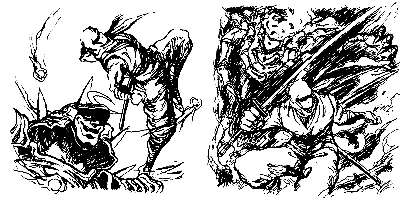
Fast forward more than twenty years and we’re at a time where the new Ninja Gaiden series is about to reach its third title as well, helmed by two designers who had previously also worked in the shadows. Fumihiko Yasuda, level designer of Ninja Gaiden II, and Yosuke Hayashi, programmer for Ninja Gaiden and director of the series’ Sigma remakes.
However, with a great history comes a great shadow. The original Team Ninja had set the bar high with Ninja Gaiden Black and Ninja Gaiden II –there was a lot to live up to and with a mostly new team no less.
Ninja Gaiden 3 would be their first real title where they could be free, without bounds, to make what they truly wanted. A new Ninja Gaiden. And joining them to write the game’s tale … none other than the aforementioned Masato Kato. Their goal?
To take the series in a new direction.
History has a way of repeating itself.
(一)
CHAPTER ONE
market shift
Set an artist free and he will fight to prove to the world that he is worthy. A notion we can feel in Hayashi’s words when Ninja Gaiden 3 was first revealed at the Game Developers Conference of 2011:
“We want to show the future of action-games.”
Ninja Gaiden 3 would not be the first title where he was at the helm but it would be the first where he had direct control over a completely new title. The aforementioned Sigma remakes aside the only other credit to his name as director was for the Nintendo Wii title Metroid: Other M, a game where he shared the director’s seat and experienced little creative freedom.
Though the ambitious goal had been set, a lot had happened since Ninja Gaiden II was released in 2008. Gaming had seen not just Arkham Asylum popularize its freeflow fighting system but also witnessed Uncharted 2 starting the cinematic gaming experience. Call of Duty claimed online dominance from Halo, breaking sales record after sales record, while it had also witnessed God of War 3’s release; a game that Team Ninja predecessor Itagaki once called the only true rival on the horizon. And let’s also not forget the release of games like Demon’s – and Dark Souls, showing that difficult games still had a place in the world.
Despite the Souls series slowly growing a cult following, the conclusion Team Ninja drew from these developments was that cinematic games with an emphasis on story, exposition and a strong multiplayer mode were on the rise, and perhaps even the future. Paired with a fading interest by the market for the more technical action games in favour of freeflow fighting as seen in the aforementioned Arkham Asylum and also The Witcher 2 – Team Ninja had set their mark for 2012’s Ninja Gaiden 3. And for the first time, it would launch on both the Xbox 360 and Playstation 3 on the same day.
(二)
CHAPTER TWO
dark hero
As Team Ninja’s new game begins, players are greeted in a different fashion than they are used to. The game starts at the story’s end showing Ryu unmasked for all to see, slowly walking to a larger than life daemon – holding the control stick upwards to do so. What follows is a large collection of quick-time-events where the player has to press the buttons shown on the screen. Just as Ryu is about to deliver the killing blow the game fades out into another cutscene.
All in all it takes nearly 7 minutes for Ryu to be standing atop a statue that the game really begins. Terrorists that have overtaken London and as players command Ryu to dive down they are immediately prompted to once again press the button shown on screen, this time for a cinematic kill.
Afterwards the first real fight finally begins against the soldier’s brethren. While the previous game’s mechanics are still present – like the dodge, light and heavy attacks paired with shurikens and a bow – new mechanics and revised ones arise soon after. The foes act tough, spouting quips and taunts until Ryu gets close and starts slashing at which point he’ll, seemingly at random, enter a new animation:
Steel on Bone
断骨
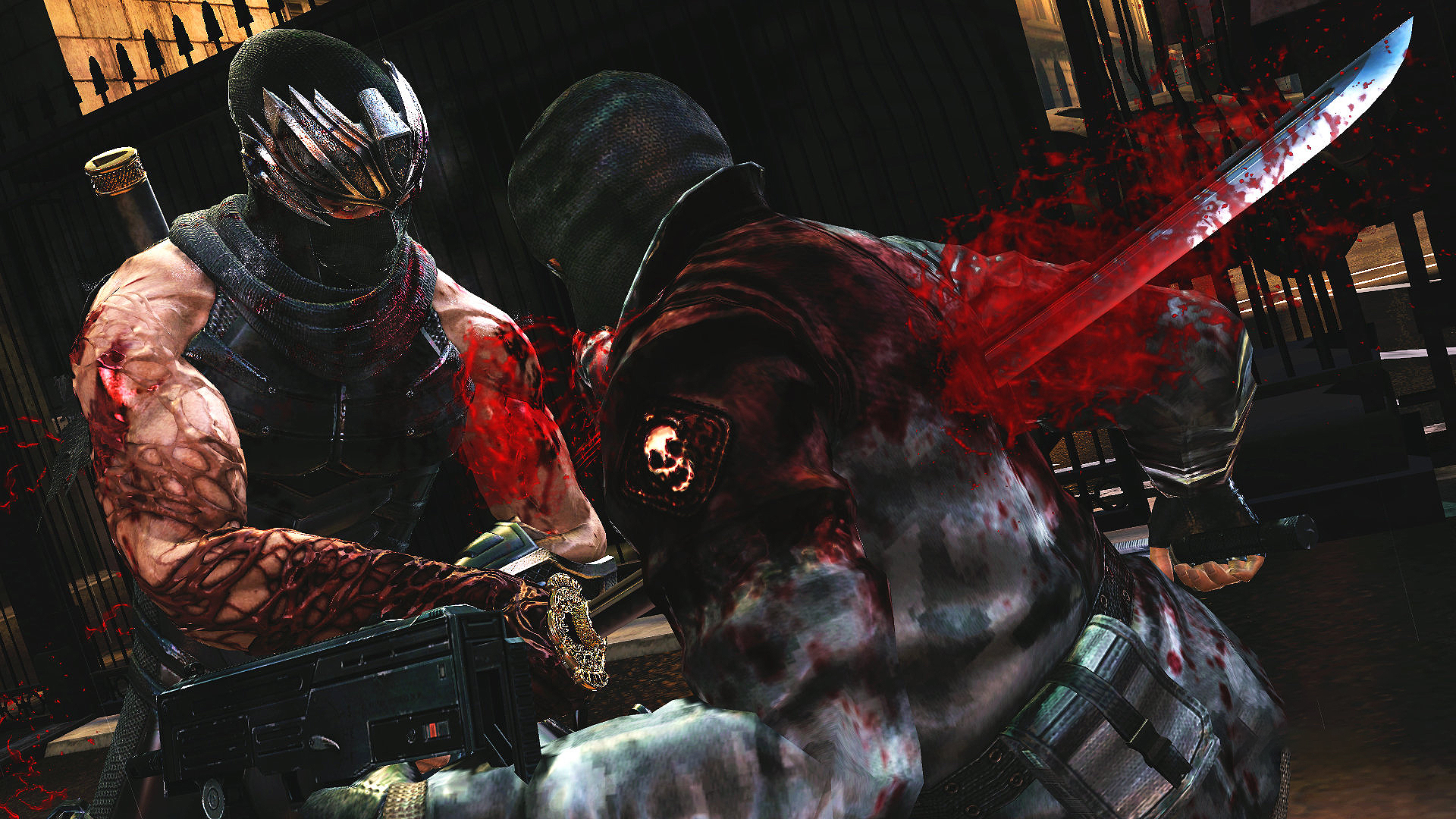
Having analyzed trends and their goal etched in their mind, Team Ninja centered Ninja Gaiden 3’s tale more on Ryu’s personality and history. Portraying him as a ‘dark hero’: a protagonist who commits evil deeds, like murder, for the greater good.
Steel on Bone is that concept put into the game. As the animation starts the camera zooms in on a close-up of Ryu’s sword entering the side of the enemy who desperately tries to stop it from cutting further though his flesh and bone. A button prompt then appears as the struggle reaches its apex. When pressed the blade cuts cleanly through and the enemy falls, crawling on the floor clinging to life for a few seconds before passing away.
To make the struggle more intimate, Team Ninja chose to tone down the gore compared to Ninja Gaiden II. Limbs no longer fly left and right, fearing that this would desensitize players to the horror of killing. “If it is just heads and limbs flying, the enemy becomes an object, not a person” according to Hayashi. As such the violence comes from the facial expressions and a rasping sound effects of bone being crushed.
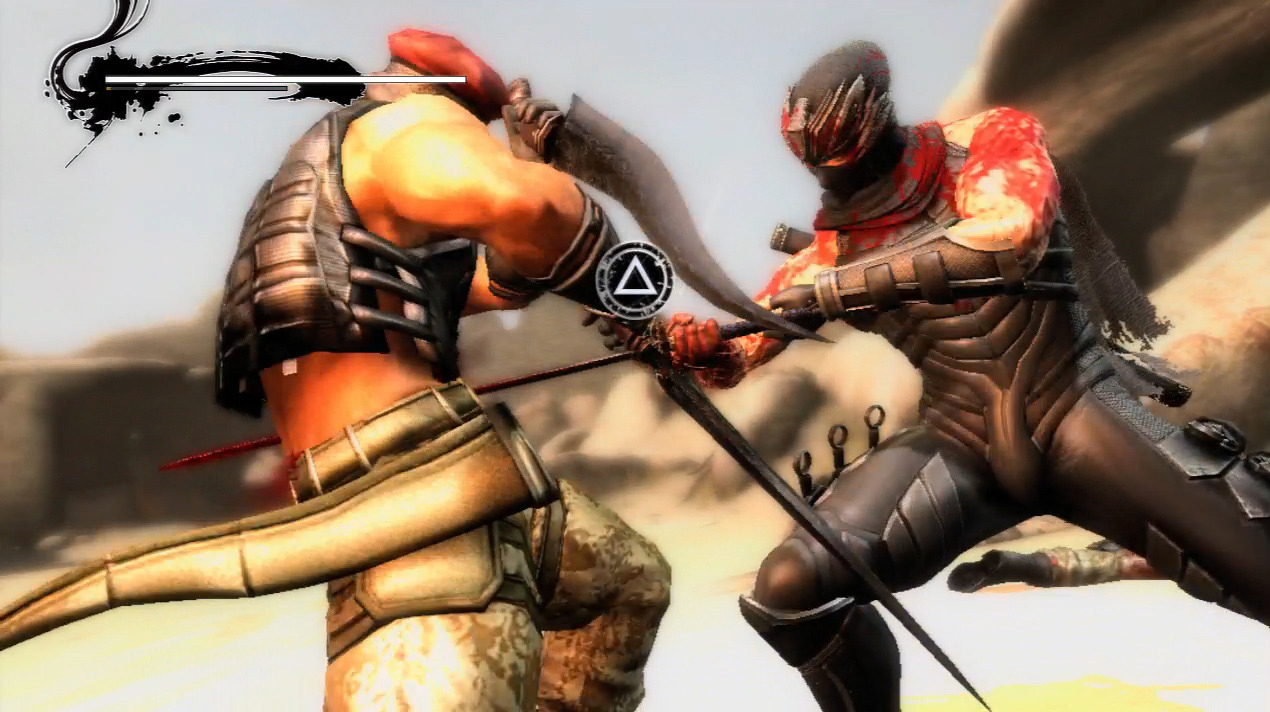
Meanwhile Ryu continues killing, as the game allows Steel on Bone to be chained from one foe to the next until the sequence fails. As these enemies fall, a magic-meter slowly fills up and when fully energized allows Ryu to summon the True Inferno Dragon to eat a large amount of enemies in exchange for health. Those that survive the dragon’s rage are left helpless, begging on their hands and knees for Ryu to spare them. He can then choose to walk past them, or kill them using an attack with a kill animation akin to Ninja Gaiden II’s Obliteration Technique that now also restores some magic.
This is important as the meter drains after every fight, converting into health. Ninja Gaiden 3 generally does away with things like shops, Essence, menus and other elements one could consider immersion breaking. You don’t save at a randomly placed statue shaped like a dragon, instead it is Ryu’s eagle that allows you to save.
We see this in Ryu’s design as well, sporting a costume that retains the old black aesthetic while also adding more smooth surfaces and straps, making it feel more like a wetsuit – a ninja of the modern era.
What sticks out in his design though is Ryu’s cursed arm. No longer does the player wield the legendary Dragon Sword, instead they use a number of swords throughout the game while Ryu’s signature blade is trapped in his arm – with the screaming souls of all those he has killed clawing at him.
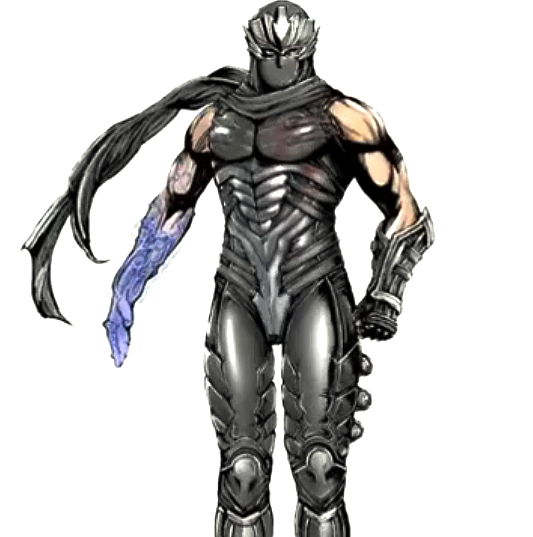
This visual and narrative change also transitions to the gameplay, just like Steel on Bone. Killing a certain amount of enemies leads to the arm glowing allowing for an Ultimate Technique where Ryu teleports around the screen instantly killing a few enemies. While this type of move was always a big part of the series, the games have struggled with Ultimate Technique Chaining: the act of absorbing Essence from fallen foes to fuel an Ultimate Technique which kills enemies, which drops more Essence, ad nauseum. This technique was so powerful it could be used to clear rooms safely without taking any damage and it is interesting to see Team Ninja try to balance this.
In addition to seeing immersion breaking elements being removed and narrative elements directing game design, Ninja Gaiden 3 also adds short sections where Ryu has to walk forward aiming for more player immersion. Radio Calls are added, as well as short stealth sections and longer cutscenes. Despite being half the length of Ninja Gaiden II, its successor sports nearly 40 minutes more cutscenes. Lastly, because the story centers around Ryu and his blade, the Katana is his only weapon this time around compared to for example Ninja Gaiden Sigma 2’s nine melee weapons.
It is interesting though to see story directing gameplay in a series that once chastised its designers for making cool fish floating in the background, forcing them to be turned into enemies instead.
Looking back, this emphasis on story should be no surprise. While Ninja Gaiden is remembered as hardcore, it was originally also a very cinematic series. Sporting detailed and cinematographically complex cutscenes, as well as a rich story, for its era. While the rebooted series focused more on the hardcore element of the original games, Ninja Gaiden 3 seemingly goes back to focus on the cinematic part.
(三)
CHAPTER THREE
focus
A change in focus isn’t new to Team Ninja. Each Ninja Gaiden game tried to re-invent its vision or add something fresh and the same is present here. To focus more on the narrative, exploration is now fully gone in favour of a more streamlined setup. You enter a room, enemies appear, there’s a cutscene or perhaps a dialogue and then a hallway to walk through to the next fight.
While we’ve outlined some of the game’s added elements and how it changed compared to previous titles, we’ve yet to ask the most important question: how does it play? As noted, the general basics remain. Ryu still has his agility allowing for jumping off enemies’ heads and walls, though he can play less with the environment through off-the-wall attacks and cover is less frequent. His moveset now also includes the ability to hold down buttons in between commands for different attack-chains.
Generally speaking the foes are familiar in how they fight. They duck and weave, are as aggressive as in games prior, though they tend to block a lot more than we’re used to. This is even more present in later foes like the claw wielding Celsus Fiends that dodge around frequently or the nimble Alchemists that have shields that need to be broken first with heavy attacks.
Enemies come in large waves at a time, making each brawl feel huge and larger than the last one. The reason behind this is that Steel on Bone allows for players to quickly decimate a whole wave in a single chain. To steer players into using this mechanic more, enemies also have a lot of health.
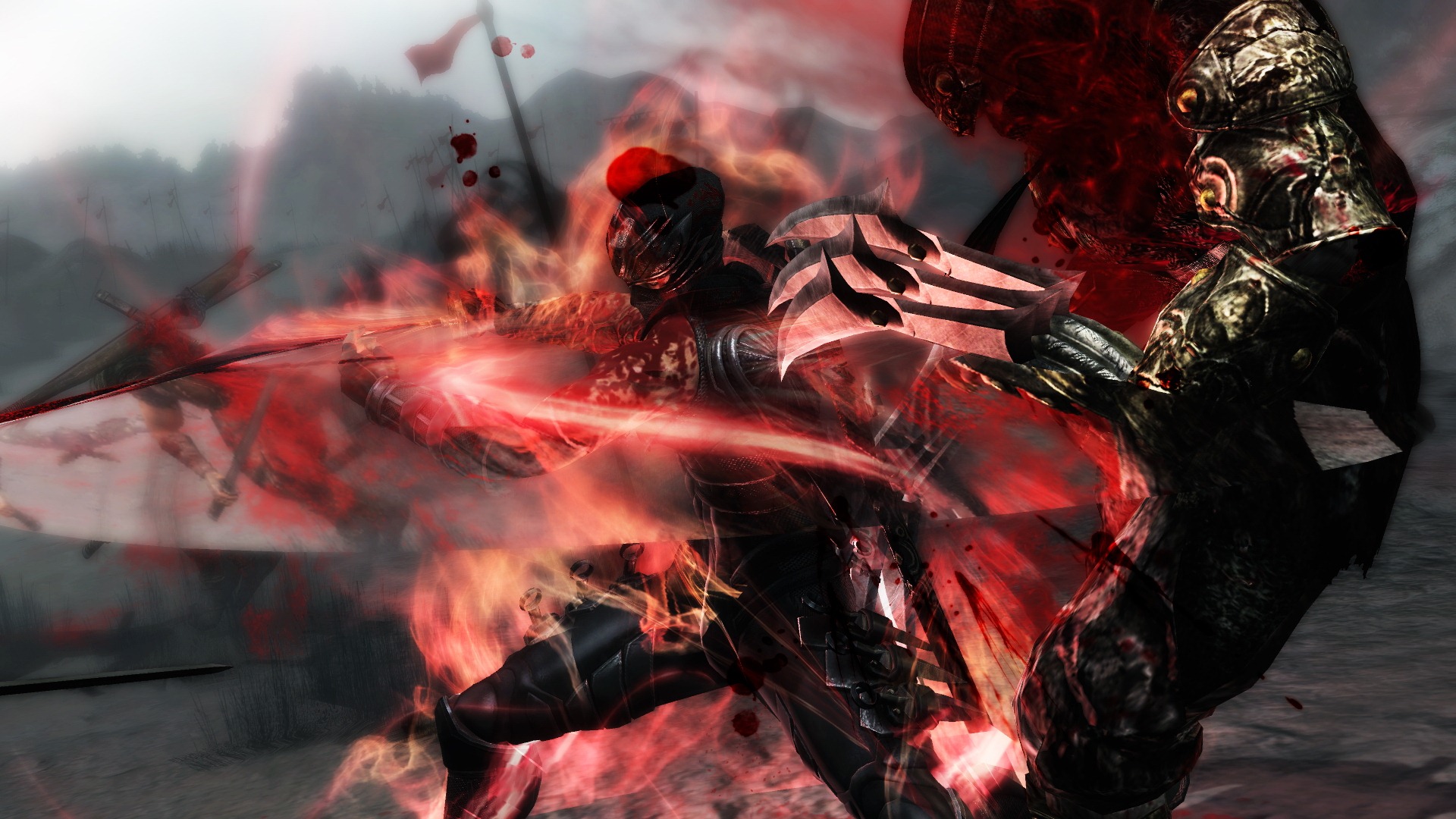
Instead of trying to kill enemies like the tanky gorilla looking Megaselion with repeated heavy attacks, the game wants you to chain your Steel on Bone chain from weaker enemies to them to kill them instantly.
When written down like this it sounds like an interesting setup that allows Ryu to quickly massacre groups of foes, while also sporting a more intimate element to the brawl. But the mechanic has a key flaw: it is generally random to activate.
While there are a few ways to trigger it semi-reliably, there is an element of randomness to it. Not just to its activation, but also the continued chaining, which can sometimes straight up stop. As a result, the mechanic cannot be trusted, leading to players opting more towards safe and efficient approaches to killing enemies. An expected development considering how dangerous enemies are in this series.
Regular soldiers are best slain with an aerial headshot with the bow thanks to its added bullet-time. Green Berets are best killed with a Flying Swallow after jumping off their heads, Alchemists with knockdown attacks followed by an Izuna drop – the list goes on and on. The same goes for bosses who are so unpredictable in their random invincibility and blocking that they are very unsafe to attack. Even your counter, a move that requires precise timing to pull off, can be countered, blocked or dodged.
There is some fun to be had in figuring out what the most efficient and safest way is to kill each foe. Yet, because of all the above, the large waves that were meant to be decimated in seconds can take up to ten minutes each with a single mistake spelling death, resulting in a boring and drawn out fight. Something that isn’t helped by the fact that the more powerful attacks in Ryu’s arsenal, the Ultimate Technique and True Inferno Ninpo, are disabled in many fights.
This isn’t so much of a problem on the game’s lower settings where the danger is low. Noting that “nobody wants to play on easy”, Team Ninja added playstyles, starting with Hero – whose goal it is to make players feel like a hero regardless of skill level. In this mode enemies are less aggressive and Ryu blocks attacks automatically.
The Ninja playstyle has two modes, Normal and Hard, which can be considered the playstyle present in previous games with the difference between the two being damage taken and done.
Master style is unlocked by beating the game, which contains Master Ninja and – added later on through downloadable content – the new Ultimate Ninja difficulty. These are difficulty modes that mix up enemy locations, add more dangerous foes earlier and as a result make fights take even longer.
The term ‘playstyle’ wants to indicate a different approach to difficulty systems of the past, but this seems to not be the case. Instead of changing how these settings allow players to play, they simply categorize them with the lowest one taking gameplay away from the player.
“It’s not that they are bad, it is what they are used to,” while a good idea at heart, Hero Mode practically disallows failure. Because players are not punished for mashing buttons to victory, it breeds bad habits for any possible future attempts at other difficulty modes. Instead of seeing the lower difficulty add a safety net to teach players how to learn to play the game, it plays it for them.
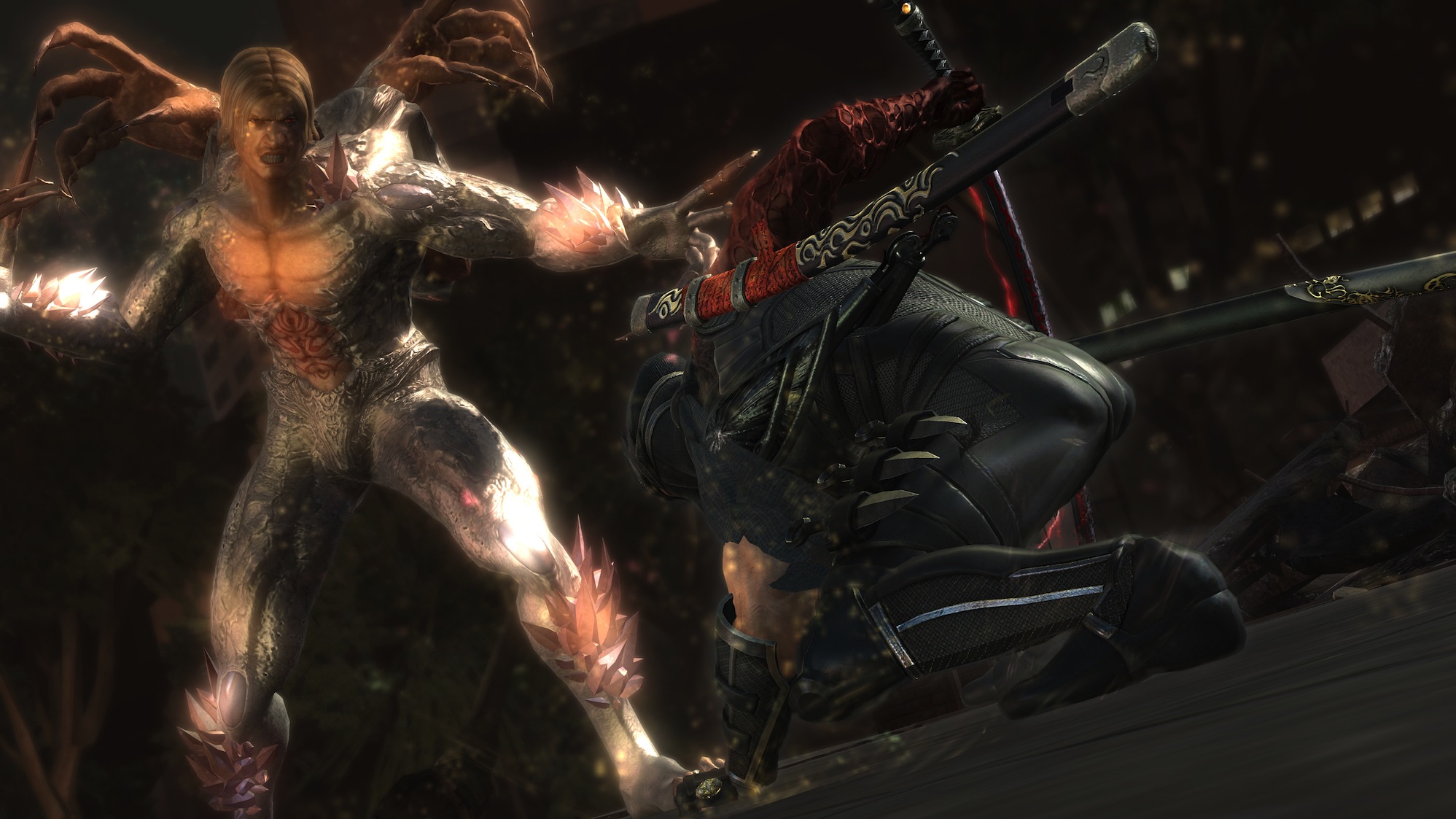
Though Hero mode is too easy, Master Ninja is another beast entirely. The legendary difficulty mode from series past returns with all that comes along with it. Stronger enemies like the dangerous Alchemists appear as early as the second fight and waves are even longer as noted. The first fight alone takes nearly five minutes where a single mistake spells Game Over.
What’s immediately noticeable when playing on this mode though, is the slowdown. Also present in Ninja Gaiden II when it originally released on the Xbox 360, Ninja Gaiden 3 starts to crumble when fights get too large on Master Ninja. While the Xbox 360 version outperforms the Playstation 3 slightly, both will sink from 60 frames per second to 34 with added slow-down and dropped inputs.
Ironic, as when interviewed, Peter Garza from Team Ninja noted that 60 frames per second was a high priority. He stated: “if we lose that, we lose existing fans“. A dangerous prospect they were getting closer and closer to.
Despite these shortcomings, a more interesting play-style can be developed. By dodging into them, weakened enemies can be launched into the air semi-reliably. This can have players start a Steel-on-Bone sequence, while the newly added on-landing attacks are used to keep up the pressure after a juggle. Using the new hold heavy attacks that cancel into finishers, as well as using headshots with the bow in mid-air during an aerial combo, players can turn the slower, more efficient strategy into one that’s more entertaining to play if one is competent enough to not slip up. While this case could be made for any game with a lacking combat system, at least this one allows it.
Embed below is a video showcasing this by the fantastic Chinese player, Gigue.

Attentive players would note the usage of the Falcon’s Talons from Ninja Gaiden II. This is because the game sported content available down the line as part of its new multiplayer mode.
While action games have dabbled with cooperative play before like in Devil May Cry 3 and Ninja Gaiden Sigma 2, Ninja Gaiden 3 features an online versus mode and large selection of cooperative missions – again showing that burning ambition to add new elements not just to the game but to the genre.
In these online modes players can hack it out against one another in one big free-for-all or a team deathmatch. Aside from the standard katana moveset they’ll also be able to turn invisible, dive like a falcon from vantage points, toss a smoke bomb to escape fights or even take their own life to avoid giving an opposing player credit for the kill.
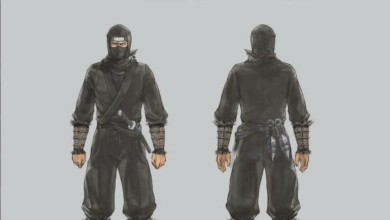
By having Ryu and the online Ninja share the same moveset, players can easily jump into the mode without feeling estranged. This is immediately noticeable in the Versus Mode where players are constantly dodging around and blocking attacks. Only when a player is overwhelmed, or the frequent delays and connectivity problems hit, is the player’s guard broken. Because the combat mechanics are shared between both the singleplayer and multiplayer, the combat feels tacked on in the multiplayer as the singleplayer and its narrative were the clear focus.
Back in 2005 Ninja Gaiden Black had challenge maps where Ryu would duel an evil clone of himself, and though this would be less marketable as a melee-alternative to Call of Duty’s team deathmatch, this style of one versus one combat in a dojo might have been more interesting. A lesson Team Ninja might learn in the future.

Regardless, Ninja Gaiden 3’s multiplayer would remain unique in the genre until Platinum Games launched Anarchy Reigns, an action game fully focused on multiplayer, four months later. Unlike most other online games from that generation though, the online portion of Ninja Gaiden 3 is still up and running if players are in possession of the Online Pass – another relic of that generation.
(四)
CHAPTER FOUR
essence
Putting all the pieces together a picture is slowly being built of Ninja Gaiden 3. While featuring a distinctive direction with unique offerings like multiplayer and a higher focus on narrative through gameplay, its quality does not live up to the previous games despite the raging ambition of its creators.
This does beg the question: what made Ninja Gaiden so good that is missing here? For instance, it could be argued that this game is a return to form to classic games from the 90’s with just a single weapon and most encounters being almost puzzle-like in design, but even then it is missing that ‘something’.
If we were to boil down Ninja Gaiden as a franchise into three key characteristics, they would be:

SPEED 
EXPERIMENTATION 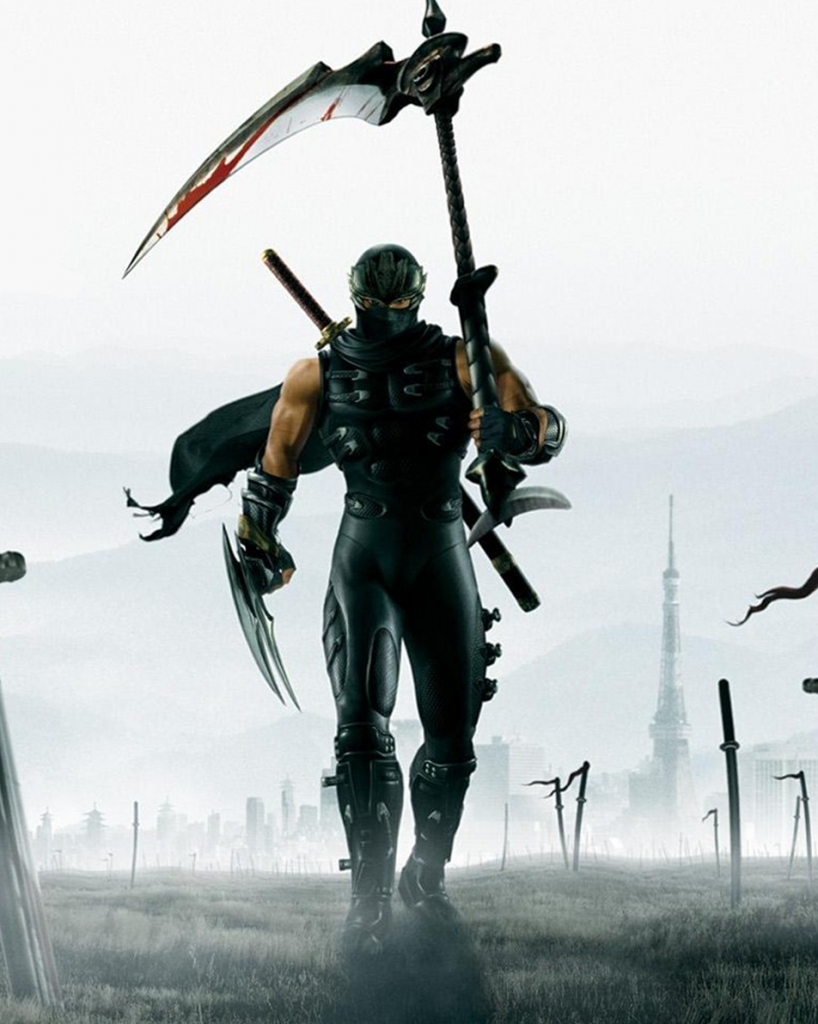
AGILITY
Combat in Ninja Gaiden has always revolved around the speed in which combat passes by. Enemies are highly aggressive and can kill you fast, just as you can quickly cut them to shreds. Thanks to the omission of elements like one-hit-kills from the older games, or on demand Ninpo, Ultimate Techniques or Obliterations from the Team Ninja titles, Ninja Gaiden 3’s speed is halted. Enemies are still aggressive, but block and dodge constantly, have a lot of health and come in huge numbers, slowing the game’s pace down.
Previous games circumvented this by offering numerous weapons, sub-weapons or magical spells to allow experimentation. Specific encounters in Ninja Gaiden on the NES could be simplified by using a Spin Slash instead of Flame Wheels, while using the Falcon’s Talons instead of the Dragon Sword could make the key difference against Elizabeth. Ninja Gaiden 3 however only features one weapon, severely limiting this element.
Lastly, agility. While fighting has been the main forray of the series, what set it apart was Ryu’s ability to use the levels to his advantage. Clinging on walls, jumping off pillars or even hopping on heads with numerous options leading from any one of them. As mentioned before, Ninja Gaiden 3 mostly does away with this by making off-the-wall attacks very weak and also vastly reducing the amount of scalable walls in combat.
Add the randomized element of Steel on Bone and a bigger emphasis on story and multiplayer – two trends of the era – and you start to lose what made Ninja Gaiden, well… Ninja Gaiden.
That’s a big sacrifice to make to tell a story. A tale that, in short, focusses on humanizing a person portrayed as a killer. Its message being that murder is violent, disturbing, personal and that it most of all risks stripping you of your humanity. In that sense though, this is a tale featured in a game that rewards you by filling your magic-meter if you slaughter the defenseless and rarely gives you the option to stop the senseless slaughter. Forcing the player to kill over two thousand foes, without a chance to say no, takes away the feeling of guilt. As a result, the message falls on deaf ears; its only legacy being the impact it had on the combat.

The only part that seems distinctly Ninja Gaiden is the Shadows of the World Mode, a take on Mission Mode from the previous games. These feature short combat maps where players fight a few waves of interesting enemy combinations that usually end with a boss fight. While playable solo, later missions are built more for two players but the game never takes the option away from the player to challenge himself by going in ronin style.
Here players are free from the constant narrative and can enjoy what remains of the combat engine, with the Ultimate Ninja trials offering a challenge that can only forge the strongest of bonds. Despite this silver lining though, it is clear that Ninja Gaiden’s main foray was moving more away from its core, with less polish to boot. Something that was reflected in its reception both when unveiled as well as upon and after release.
(五)
CHAPTER FIVE
reasoning
Their new vision failed to resonate with both its original audience and the newly targeted one. Public reception upon seeing the first gameplay trailer was less than positive. The added Quick Time Events, constant communications with Ryu’s busty handler Mizuki and seemingly neutered combat in favour of story appealed to neither side.
Then why change? Why aim to capture an audience that wasn’t originally interested in your series in favour of an audience that was already dedicated to it? One could note higher sales, it is a business after all, and there have been games that have succeeded in this. The classic God of War married a casual audience with a hardcore one thanks to its combination of easy to understand combat and interesting story. Meanwhile titles like The Elder Scrolls IV: Oblivion and Fallout 3 saw success by streamlining – or if you wish, dumbing down – their systems, making them more understandable to newer generations.
What these titles did not attempt though was shifting their focus so completely; instead only the layers of complexity changed: Oblivion did not remove exploration or character building from its game, it was only simplified with other elements being offered in return.
Looking deeper into the game’s trailers and other published material shows that there might have been more going on behind the scenes than we think. One trailer saw the Wind Blades Ninpo being equipped. Also, a 3d model of the Falcon’s Talons weapon was seen in an interview nearly a year prior to the game’s release, same with a poster featuring the Eclipse Scythe.
It was around that time that Ninja Gaiden 3: Razor’s Edge was announced as an exclusive WiiU launch title. At first it was assumed that this was just a port, but one could wonder if content was left out on purpose which would later be added to that version or as downloadable content.

And they would be right. Three weeks before Ninja Gaiden 3 launched, a trailer announced that the Falcon’s Talons would be available as downloadable content paired with some new cosmetics and trials. Perhaps this was an attempt to curb the negative perception; a hope for redemption.
Though these minor additions didn’t give it, redemption was what the game would need. Not just for the series but also Hayashi and Team Ninja. Their first game ended up being what they wanted to make, but it was not what people wanted.
That is a painful message to receive. It is difficult to work within the confines of a creative property of a team long gone. Their first titles were new additions to existing series. A new Metroid, a new Dead or Alive and now a new Ninja Gaiden. Perhaps what they needed was something new that they could make their own. And it would just so happen that a canceled game from 2005 was just handed to them. Could that could turn the tide?
Until that would happen,Team Ninja would have to prove that they could still deliver a quality action title that they were known for. Razor’s Edge’s release on the WiiU was but eight months away from Ninja Gaiden 3’s launch. The series had risen to fame on a Nintendo system… would it also end there?
History has a way of repeating itself.
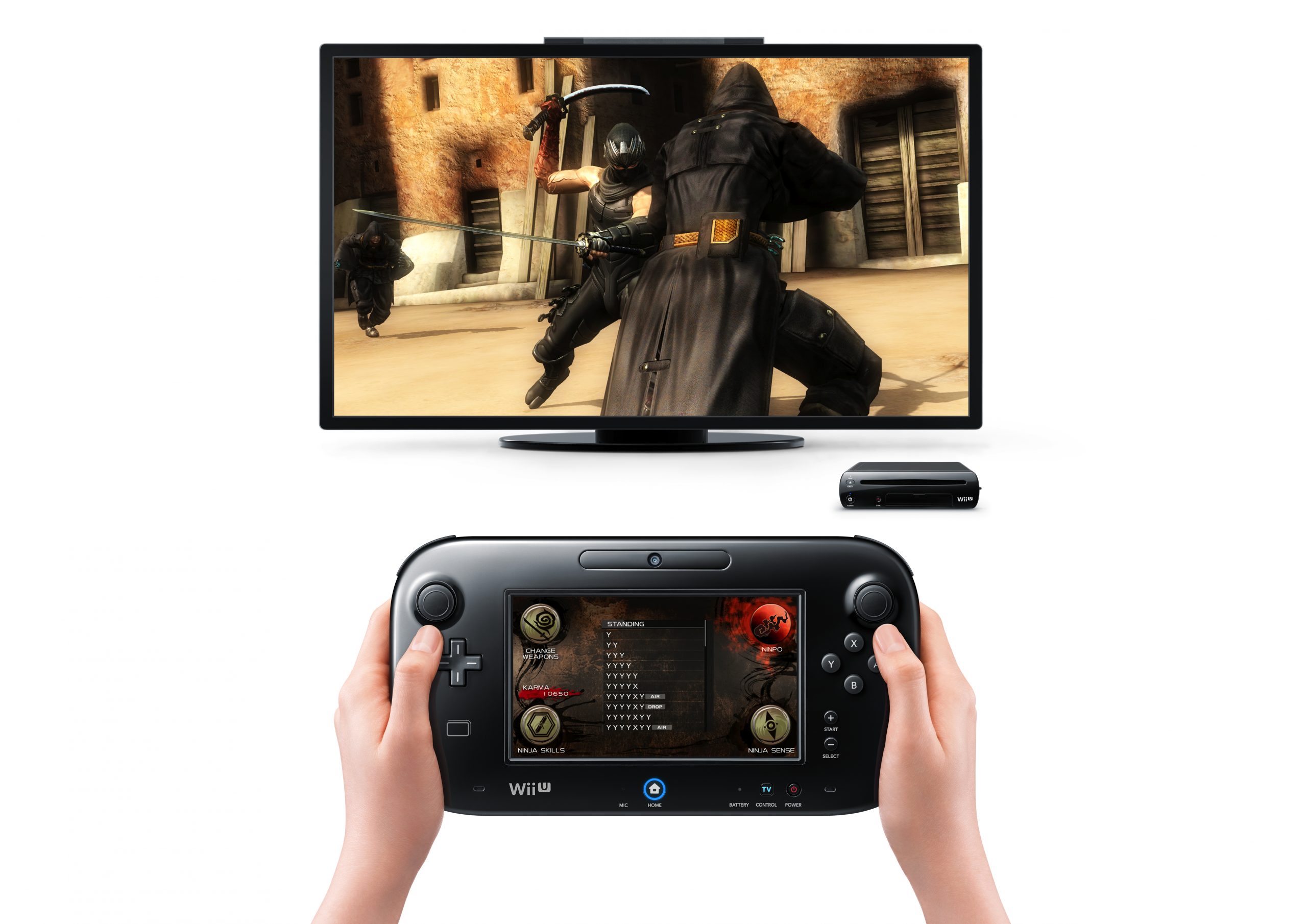
鑒 reflection style 鑒
In this short section I reflect on the article from my own viewpoints as a gamer and lover of the genre instead of a critic.
Ninja Gaiden 3 to me was the first game in the series that I would play on launch. I still recall playing the game as it came out with one of my best friends who was at my home at the time. We popped in the disc, and though I was optimistic it would get better, we both felt something seemed off.
As I played more I was disappointed that, despite the promise in earlier interviews, there was no more than a single weapon. I felt the game was more frustrating than fun. This was heightened when I tried to beat the game’s Master Ninja mode before the downloadable content was released. I vividly remember struggling heavily at the final boss who would often crash the game or see Ryu fall through the floor all the while talking to some of my fellow Ninja Gaiden fans like Phandral over PSN.
But still there was this bond between players as we suffered together with fun being found in the online trials, to the point that I did in fact gain the Platinum Trophy.
While researching this topic it was depressing to see how much talk was done about the story and how little gameplay seemed to matter. It was an era where the market was shifting from being just a hobby for – pardon my words – geeks and nerds, to a holywood-like sector. And it shows. Team Ninja tried to go big and failed, in what could be one of the most important games of the generation. Not because of its success, but because it failed.
I would not be surprised if Ninja Gaiden 3 is often looked at by companies looking to change their formula in a lesson on how not to handle it. Perhaps great games like DOOM 2016 would never have focused on its original concepts instead of their plan to make a story focused shooter had Ninja Gaiden 3 not shaken them. Who knows what direction titles like Devil May Cry or Platinum Games’ latest outings would have taken had Ninja Gaiden 3’s focus on narrative been a resounding success.
As such I don’t hate Ninja Gaiden 3, since it could very well have prevented a slew of bad games. Had it been successful, then I would’ve hated it.
斬 postscript notes 斬
- The new rival, the Regent of the Mask, looks eerily similar to Jack of Blades from Fable;
- I will always find it weird that this game features regular soldiers that manage to sneak up on Ryu. Not exactly a master ninja…
- One of the developer’s diaries constantly has birds chirping in the background. It is so unprofessional it makes me smile;
- For a game so focused on its tale, it showed a ton of spoilers in the trailers like the acquisition of the Blade of Archfiend, Genshin and much more;
- One of the earlier interviews already notes that “Ultimate Ninja difficulty” will return, which is interesting since this would be the first time it was featured in the series;
- Though the game featured Move Support, Kinect support was tried and dropped early in development. They couldn’t find a way to find the ‘sword connection‘ with Kinect, unlike with Move. They did promise that Xbox 360 users would get something special though since they had been a loyal fanbase since the beginning. This content was never delivered upon;
- This kind of builds on the previous note, but the total amount of lies present in the build up to this game’s release is astonishing. From the aforementioned Xbox 360 exclusive content and mention of unlockable content to promises of multiple weapons and 60 frames per second being a high priority – if a game would lie like this in this day and age it would be crucified;
- The original concept for Ryu’s arm was to have it slowly be covered with dragon scales as the story progressed, with him being nearly completely covered in them at the tale’s apex. Weird that they eventually settled for just some basic red veins;
- The game’s menu uses vertical text, which looks just fine in Japanese and Chinese, but is absolutely unreadable in English;
- While most of the game’s songs aren’t that impressive, the song A Hero Unmasked is an absolute standout and one of my favourites of the series. Originally this theme would serve as a red line for this article; in how Ninja Gaiden 3 ‘unmasks’ the old Team Ninja as the heroes. I eventually dropped this as I felt it was disrespectful to the team that would eventually make Razor’s Edge and Nioh;
- One could argue that Demon’s Souls did online PvP first in terms of action games. But it didn’t feature a full on team deathmatch mode, thus I left it out;
- Despite making Steel on Bone such a key part of the combat, players can run the risk of being desensitized by it. Steel on Bone only features 3 unique animations, compared to Ninja Gaiden II Obliteration Technique featuring over 30;
- Because the eagle can only be used to save once, the problem of save-scumming after every fight as seen in previous games is now gone. This makes No-Damage runs a lot more difficult, if not impossible.
- Interestingly, later challenges seem to slowly build towards regular enemies being completely replaced by boss-fights, with the last set of challenges seeing more Fiend Genshins than regular enemies at times. Subsequent downloadable content added even more maps to conquer while adding more older bosses as well like Doku, Alma and Zedonius.
源 sources 源
- https://www.youtube.com/watch?v=KN-xEfIkQv4
- https://www.youtube.com/watch?v=I83KXJ0D_m8
- https://www.youtube.com/watch?v=FoWSnpOffaI (best interview in my opinion)
- https://www.youtube.com/watch?v=k9UaTkRZgPU
- https://www.youtube.com/watch?v=4sOH9QonLJA
- https://www.youtube.com/watch?v=63KmVCL02Ls
- https://www.youtube.com/watch?v=OWTf8r1JyaE
- https://mynintendonews.com/2012/03/15/team-ninja-talks-about-that-controversial-metroid-other-m-collaboration/
- https://www.nintendo.co.uk/Iwata-Asks/Iwata-Asks-Metroid-Other-M/Vol-1-The-Collaboration/1-A-NES-Game-with-the-Latest-Technology-/1-A-NES-Game-with-the-Latest-Technology–224960.html
- https://www.ign.com/articles/2011/01/25/ninja-gaiden-iii-saved-or-ruined
- https://www.ign.com/articles/2011/01/25/ninja-gaiden-iii-will-be-completely-different

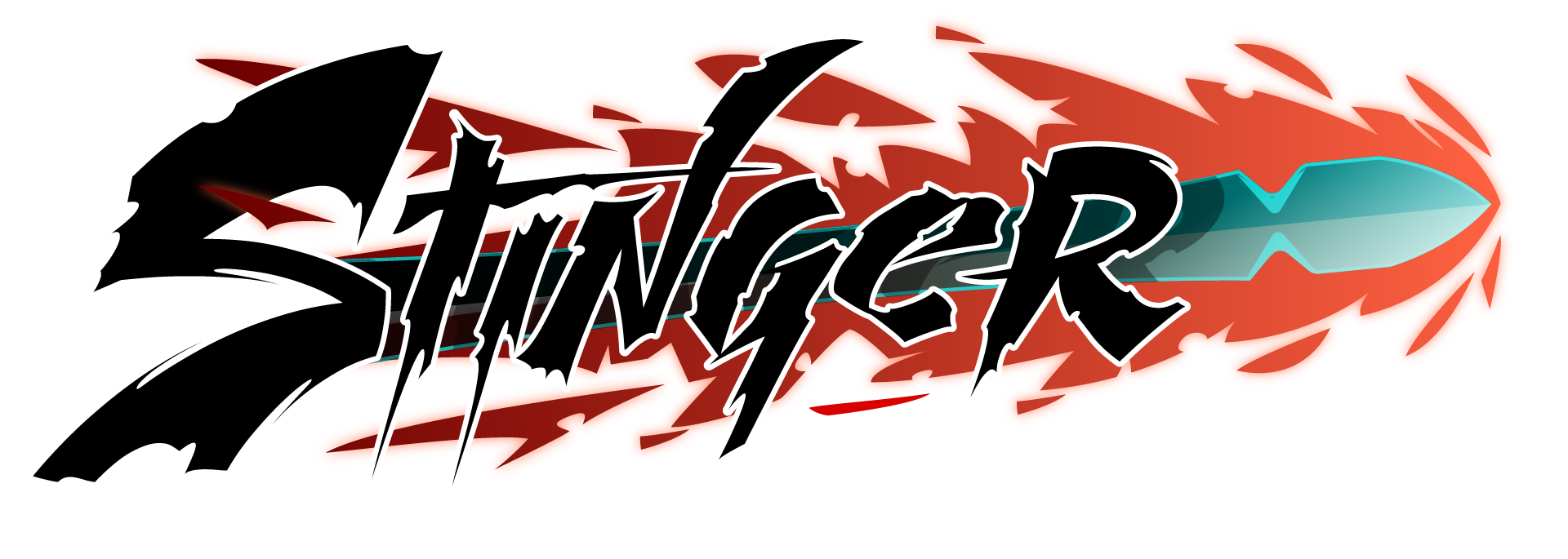
Excellent article, thanks. Sounds like they handled the easy mode in the worst way possible. I think that in a game of this type,. the goal of an easy mode should be to make more hardcore gamers. It should be use to ramp them up to the normal and hard modes, IMO. And even if you include an easy mode, I don’t think anybody is truly buying one of these kinds of games expecting there to be no challenge involved: As a result, I think that most easy mode players would find NG3’s Hero mode to be insulting… I guess you could say the same about Ninja Dog mode in NGB, however, to me, the way the game mocks you for picking the easy mode is the developers trying to encourage you to aim higher. I think that’s a much better approach. I think it’s part of the spirit of gaming to mock people for making it easy on themselves, and that can be taken as you putting them down but in most cases, I actually think it’s to lift them up. Besides, you wouldn’t treat somebody that you thought was totally incompetent in this way. The phrase “git gud” implies the idea that “come on, I know you can do this if you try!”.
It’s weird how Easy Modes continue to elude designers with only a few really hitting home how it can be done properly, like for instance Ninja Dog mode in NGB or the difficulty curve in ZoE2 which, granted, takes a lot of dedication since that game has so many difficulty modes. The discussion also never goes very far though, like when Dark Souls comes along with a new entry. Some games lock content behind modes which I find interesting. RE4’s easy-mode removed some of the harder parts out-right, while a game like Contra doesn’t show it’s final boss unless played on Hard.
Hope you’re safe!
I also love it when content is locked behind the higher difficulties. I especially like the way that Ninja Gaiden adds in new enemies…. that’s literally a dream come true, to me. I mean, I long for the day when there’s more to hard modes than simply increasing enemy damage + decreasing player damage. Obviously, you could also go the Bayonetta/DMC route and treat the enemies like pieces on a chess board, with the higher difficulties giving you more difficult “puzzles” to solve via different enemy layouts. Nothing compares to the feeling of seeing a brand new enemy for the first time on a high difficulty, though. There’s something special within the presentation of that: like, you know this enemy is one bad mofo, because he’s exclusive to this here Hard Mode, haha. The problem is, games are so expensive to make these days that developers are scared of you missing ANYTHING, so they lead you by the nose just to make damn sure that you don’t miss a thing. From the developers perspective, it’s like “I spent months working on this one part of the game and would be heartbroken if you missed it”. I feel for them, but on the plus side, it’s going to be 10x more special for the players that do find the missable thing. I wish more developers would see this.